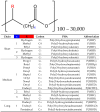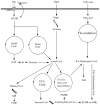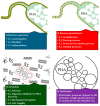A Review of Polyhydroxyalkanoates: Characterization, Production, and Application from Waste
- PMID: 39458337
- PMCID: PMC11510099
- DOI: 10.3390/microorganisms12102028
A Review of Polyhydroxyalkanoates: Characterization, Production, and Application from Waste
Abstract
The search for alternatives to petrochemical plastics has intensified, with increasing attention being directed toward bio-based polymers (bioplastics), which are considered healthier and more environmentally friendly options. In this review, a comprehensive overview of polyhydroxyalkanoates (PHAs) is provided, including their characterization, applications, and the mechanisms underlying their biosynthesis. PHAs are natural polyesters produced by a wide range of prokaryotic and some eukaryotic organisms, positioning them as a significant and widely studied type of bioplastic. Various strategies for the production of PHAs from agroindustrial waste, such as cacao shells, cheese whey, wine, wood, and beet molasses, are reviewed, emphasizing their potential as sustainable feedstocks. Industrial production processes for PHAs, including the complexities associated with extraction and purification, are also examined. Although the use of waste materials offers promise in reducing costs and environmental impact, challenges remain in optimizing these processes to enhance efficiency and cost-effectiveness. The need for continued research and development to improve the sustainability and economic viability of PHA production is emphasized, positioning PHAs as a viable and eco-friendly alternative to conventional petroleum-based plastics.
Keywords: agroindustrial waste; bioplastics; cost-effectiveness; environmental impact; extraction processes; microorganisms; polyhydroxyalkanoates (PHAs); sustainable feedstocks.
Conflict of interest statement
The authors declare no conflicts of interest.
Figures




References
-
- Plastics Europe . Plastics—The Facts 2023. Plastics Europe AISBL; Brussels, Belgium: 2023. [(accessed on 26 August 2024)]. Available online: https://plasticseurope.org/es/plastics-europe-publica-plastics-the-fast-...
-
- Hundertmark T., Mayer M., McNally C., Simons T.J., Witte C. How Plastics Waste Recycling Could Transform the Chemical Industry. 2018. [(accessed on 26 August 2024)]. McKinsey & Company. Available online: https://www.mckinsey.com/~/media/McKinsey/Industries/Chemicals/Our%20Ins....
Publication types
LinkOut - more resources
Full Text Sources
Molecular Biology Databases

